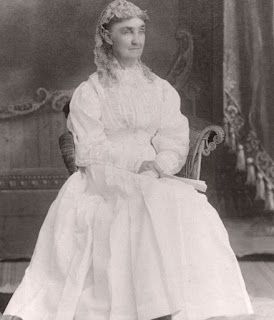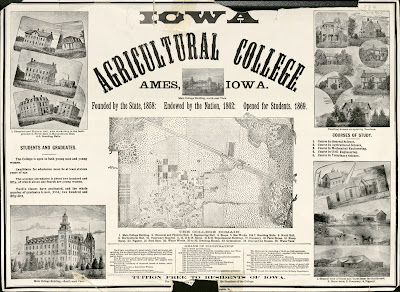entrepreneur who hailed originally from Rutland County, Vermont and married Munson cousin Maria Hotchkiss. Their children were also high achievers. That descendency is as follows:
Capt Thomas Munson > Samuel Munson > Samuel James Munson > William Munson > Martha Munson > Loly Doolittle > Hiram Hotchkiss > Maria Hotchkiss m. Seaman A. Knapp
Maria Elizabeth Hotchkiss was born in Washington County, New York to Hiram and Lucina (Pearce) Hotchkiss on 31 Dec 1833. Seaman Asahel Knapp, son of Elisha and Catherine (Wright) Knapp. Seaman was born Schroon, Essex County, New York on 16 Dec 1833. At 16, he attended the Troy Conference Academy (which later became Green Mountain College). It was while he was here he met and became engaged to Maria Hotchkiss. They both graduated and while Seaman attended Union College, Maria supported them by teaching at Princeton. After graduating from Union College in 1856 (Phi Beta Kappa), he married Maria in 1857.
The couple both had teaching positions at the Fort Edward Collegiate Institute in Poultney, Vermont. Their first child, George, was born in 1958 but would die in 1862. Seaman would serve as vice president from 1856-1863 and from 1864-1865, he served as assistant manager of the Ripley Female College (Green Mountain College). Beset by a leg injury, which had become infected, his doctor recommended he move West and "follow and outdoor life."
They took the money they received for selling the farm that Maria's father, Hiram Hotchkiss, had given them for a wedding present and headed west, but not before purchasing a few Merino sheep, which along with their two children, Maria and Herman, headed to Iowa.
 |
| Iowa School for the Blind Vinton, Iowa |
It was then that Seaman, using everything he learned, started a modern hog farm and sold the hogs to other farmers to start their own hog farms. He often wrote about improving efficiency while farming, which was much-needed information for farmers throughout the country. Seaman authored articles for the Farmer's Journal and became an expert on agricultural issues that allowed him to have his speeches published, write in other periodicals, consult with the Department of Agriculture, and become famous in agricultural circles. In 1873, he became the president and founder of the Farmer's Loan and Trust Company in Vinton where farmer's got lower interest and could successfully pay back their loans. The standard loan burden was untenable for farmers on the whole.
While the family was in Vinton, they had three more children, Bradford, Seaman Arthur, and Louise.
He accepted a position to become the head of the agricultural program at the relatively new Iowa Farmer's College and Model Farm in 1879. Curriculum was aligned to be practical and to align with the purpose of the Morrill Act of 1862.Iowa was not going to spend any additional money on research funds for the college to expand and strengthen its curriculum, so Seaman wrote several bills to try to get Congress to fund it. Finally, this came to fruition in the Hatch Act of 1887.
He then filled a one-year term as President of the Farmer's College from 1883-1884.
 |
| Maria Hotchkiss Knapp |
Included in these was his development of the Farm Agent program in Texas, whereby one man, highly trained in the economics and operational matters of farming of the most modern level, would go out to a group of farmers and instruct them in a practical way how to make improvements and efficiencies. This effort was funded by John D. Rockefeller through the General Education Board in 1902. Working with George Washington Carver, who was a well-known teacher for African-Americans, he helped develop the same program specifically directed at African-American farmers in the South.
After so many advancements and successes, Seaman went to Washington to lead the Farm Demonstration Work for the Department of Agriculture and the General Education Board. Maria moved with him to Washington. Seaman furthered his work with the farm agents and extended that program into several states.
Seaman's last major impact was the start of the boys' corn club - which was an extension of his demonstration model of farm education. It's purpose was to get young boys interested in farming so that farms could continue to produce food for the country. Soon, a similar club system was created for girls. This would be the early foundation of what would become 4-H Clubs. Unfortunately, he would never see the full force of the expansion of this program, nor would he see that his farm agent program would become something much greater with the development of county extension offices throughout the country.
Maria Hotchkiss Knapp died on 08 Jun 1910 in Washington DC after a year's illness. The couple had been married nearly 50 years. Seaman followed her 9 months later on 01 Apr 1911. The couple were buried at the Iowa State Cemetery at Ames, Iowa.
They were parents to some pretty remarkable kids as well:
- Maria would marry Augustus Mayo, one of the directors of the Eiber-Mayo Title Company. In her early life she taught privately and also did church and club work in Lake Charles.
- Dr. Herman Knapp was the Vice President and Treasurer of Iowa State College (formerly the Iowa Farmer's College and Demonstration Farm)
- Dr. Bradford Knapp was President of the Texas Technical College. He had previously been the President of the Alabama Polytechnical Institute in Auburn, President of Oklahaoma A&M College, and Dean of the College of Agriculture at the University of Arkansas. He had also practiced law for many years while in Iowa. After his father's death, he succeeded him in the extension work his father had begun.
- Helen Louise Knapp married Dr. Oliver Fay, a noted surgeon in Des Moines. Helen was a great socialite and philanthropic doyenne, throwing glamorous parties and fundraisers. Dr. Fay was previously the president of the Iowa and Polk County Medical Associations. He was also the Chief District Surgeon for the Burlington & Northwestern railroad.


No comments:
Post a Comment